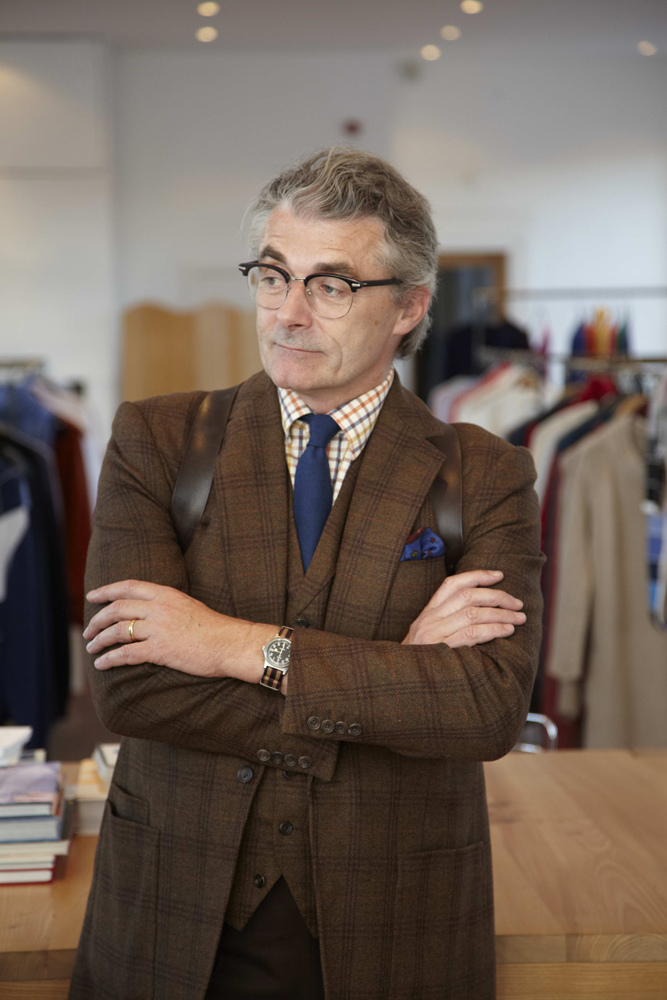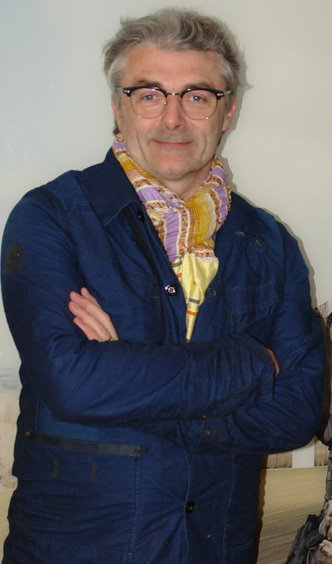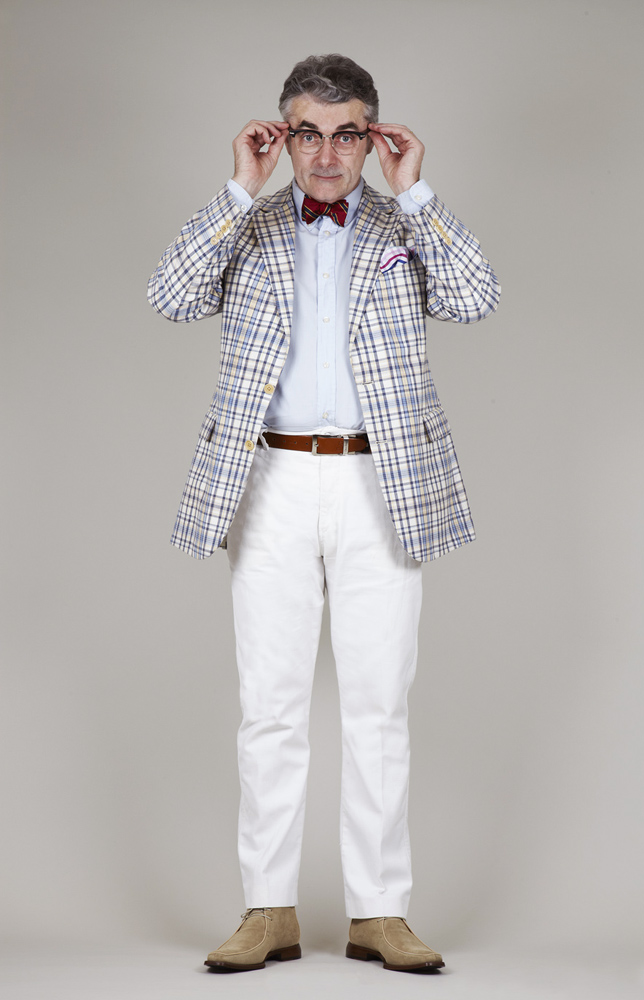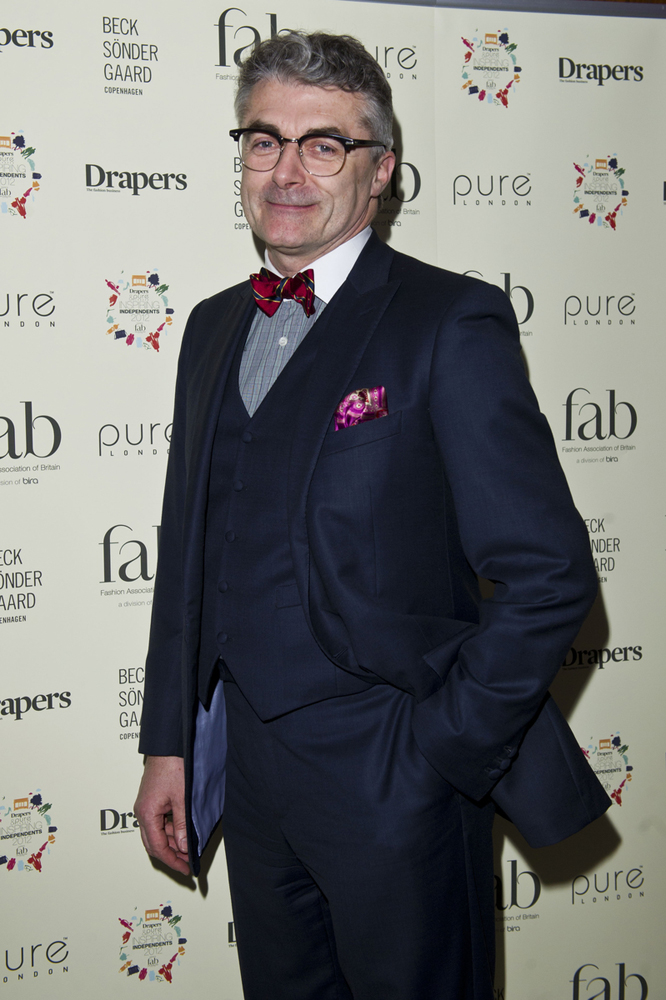Interview with Eric Musgrave
0March 23, 2013 by Ville Raivio
“I was born on May 23 1955, in Leeds, a major city in the north of England. I have been writing about the business of fashion for more than 30 years. I am now a freelance writer specialising mainly in menswear and I am the author of Sharp Suits (Pavilion Books), a pictorial history of men’s tailoring. I went to Leeds Central High School, a grammar school in my home town, and then got a BA Honours degree in History from the University of Hull. I am married to Jane Eastoe, who writes non-fiction books, including Fabulous Frocks, which is the feminine companion volume to Sharp Suits (See www.janeeastoe.co.uk).
Products from Pukimo Raivio
Ralph Lauren, Black Label suit, size 52EU
I am lucky enough to have three children: Florence (born 1991), Teddy (born 1994) and Genevieve (born 1998). My family are used to my style adventures, although they do not always applaud them. The pink linen trousers for summer seem to cause a few problems, but increasingly my wardrobe is being raided by my wife and kids who appreciate quality garments and accessories when they see them. Florence has just “borrowed” one of my favourite cashmere sweaters, a bright orange number from Gran Sasso, an Italian label. I fear I will never see it again…
My mother, who was 92 at the beginning of 2013, and my sisters, Heather and Sue, who are nine and eight years older than me, have reminded that I used to be very particular about my appearance even as a small youngster. I liked to be clean and tidy even at infants’ school, which is from 4 to 7 years in the UK. As a young teenager, I was lucky that Sue did a fashion design course; I remember with affection a couple of shirts she made for me when I was about 14. They were in Liberty prints, with matching ready-tied ties on a piece of elastic to go round the neck. In my half-hearted hippy period in the early 1970s, I did go out in my mother’s old fur coat. I don’t remember any negative reaction about my various wardrobe choices from my family – we were all pretty easy-going. These days they are surprised if I don’t wear something a bit different.
As the preceding question reveals, I was aware of clothing from an early age, but I suppose I started shopping for myself at the age of about 15. By the age of 17 and 18, I was shopping mainly in charity shops and military surplus shops. Even back then, I was into retro looks rather than what was the hot fashion look of the moment. I seemed to know even at that early age that fashion was contrived, that it was conceived to be out of date after a relatively short period. I preferred the authenticity of a Royal Air Force greatcoat, or an army surplus genuine combat jacket, or a pair of classic brogues. I loved old double-breasted suits, which you certainly could not find in high streets of the time (the early to mid-1970s).
The gathering of information is a never-ending progression. There’s always something new to be discovered. I was a magazine junkie from my late teens, but in those days I read women’s magazines as there was nothing about men’s style. I have shelves full of men’s magazines from the mid-1980s onwards, including about 70 copies of American GQs from the 1980s. I have dozens of books on all sorts of aspects of menswear. It’s fascinating to roam round the internet and to see what else is available. It obviously has been advantageous to me to work in trade journalism since 1980 – you learn a lot that is not readily available to the general public by having access to “the inside”.
My own style is eclectic and catholic. I like authenticity, whether that it is displayed in a Norfolk jacket in Derby tweed or a Carhartt chore jacket. I like classics, such as a Baracuta G9 “Harrington” jacket or an unlined Ivy League-inspired jacket by the French label J Keydge. For almost all of my adult life, I have been a chameleon, ready, willing and able to change my appearance depending on my mood or the circumstances. I am not one to regret the past, but I do wish I had explored bespoke tailoring more than I have done. My fantasy, if my financial situation improved dramatically, would be to have all my clothes and shoes made for me. What could be more satisfying than to wear something that’s unique, made expressly for you? Just over a year ago I had a jacket and matching waistcoat, plus a complementary pair of trousers, made by Savile Row tailor Kathryn Sargent, who is a friend of mine (www.kathrynsargent.com). Since then I have not been too excited by ready-to-wear tailoring. I’d rather save up for some more bespoke stuff, even if it might take a while to get the money together.
I am proud to say that the second edition of Sharp Suits has just been released in the UK (in February 2013). The first edition was published in 2009 and was very well received by fans of men’s tailoring worldwide. Credit for the book must be given to my wife, Jane Eastoe, who co-wrote with a friend of ours, Sarah Gristwood, a celebration of women’s dresses called Fabulous Frocks. When this came out in 2008 and was well received, I was invited by the publisher to write a companion volume on men’s tailoring.
I struggled for some time to work out how to tell the story of the development, globally, of the suit during the past 150 years or so. Things became a lot easier when I decided to write eight separate chapters that related to a different aspect of the story. I worked very hard with the picture researcher, Emma O’Neill, from the beginning to try and unearth images that were not too familiar. Of course, there are some classics that we could not leave out, such as Steve McQueen in a Douglas Hayward suit in The Thomas Crown Affair from 1968, but we did a great job, I would say, in pulling together about 150 images that work very well together.
The decline of the specialist menswear shop has cut off an important source of information and education for the man in the street. Specialist knowledge can be gained while working in the menswear industry, but for those outside the business it takes a lot of effort to find out the sort of information that helps make the best decisions. That’s why sites like keikari are so important. A few thoughts to share: men, enjoy your clothes and don’t be afraid to step to one side of the rest of the flock. Take time when making a purchase – when will you wear what you are buying, and what else do you have in your wardrobe to complement it? And finally, if something seems cheap, it probably is. Don’t confuse price with value; most usually, you get what you pay for.
Many years ago I used to spend a lot of time playing vinyl records – soul, gospel, country, jazz, some rock, lots of electric blues, swing, big bands – but I never have time to play them now so I am in the process of selling them. Similarly I have lots of magazines that I am getting rid of. These days my most regular pastime is walking my dog, Jimmy. I also religiously play football every Saturday morning. I am a defender; I can’t play football very well, but I can stop other people playing well.
No one gets his personal style right straight away. It’s a process of trying, refining, rejecting, improving, moving on… The biggest thing to get used to with old-fashioned, old-school, tailored clothing is that it is fitted – that is not to say that it is tight, but that it gently holds the body. That effect is very hard to get from off-the-peg clothes unless you are lucky enough to be the exact size of the imaginary man they were made to fit. There is absolutely no harm in copying a look from a photo to see how well it suits you. The difficult part is when you have to admit that maybe your shape isn’t the shape of a top movie star or a famous model.
Most of us – me included – buy off-the-peg, not bespoke or even made-to-measure, so it’s very useful to know a good, well-trained alterations tailor. Unless you are damned lucky, a ready-made garment will always need a slight alteration to get it to fit you.”
Pictures and details:
1. At Hawick Cashmere in September 2012, in bespoke jacket, waistcoat and trousers by Kathryn Sargent, shirt by Viyella, vintage wool tie, pocket handkerchief by Drake’s, backpack by Cherchbi, British Army-issue watch by CWC, spectacles by Shuron. Photo by Gerardo Jaconelli for Textiles Scotland
2. In April 2012, in jacket by G-Star Raw, hand-woven silk scarf from India. Photo by Catharina Berndt
3. In 2012, Jacket and bow tie by Brooks Brothers, shirt by Hilditch & Key, trousers by Levi’s Sta-Prest, pocket handkerchief by Otis Batterbee, shoes and belt by Oliver Sweeney, spectacles by Shuron. Photo by Camilla Treharne for Oliver Sweeney
4. In Edinburgh in September 2012, in jacket by Brooks Brothers, shirt by Duchamp, cashmere slipover by Johnstons, tie by Drake’s, spectacles by Shuron. Photo by Gerardo Jaconelli for Textiles Scotland
5. In February 2012, wearing a three-piece made-to-measure suit by Moss Bespoke, shirt by Gieves & Hawkes, bow tie by Brooks Brothers, pocket handkerchief from Without Prejudice. Photo by daughter, Florence Eastoe
Category Arbiter Elegantiae, Interviews, Writers | Tags:








Leave a Reply